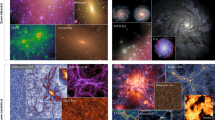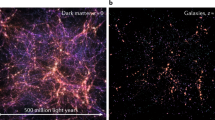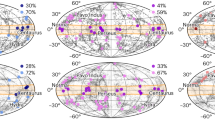Abstract
Research over the past 25 years has led to the view that the rich tapestry of present-day cosmic structure arose during the first instants of creation, where weak ripples were imposed on the otherwise uniform and rapidly expanding primordial soup. Over 14 billion years of evolution, these ripples have been amplified to enormous proportions by gravitational forces, producing ever-growing concentrations of dark matter in which ordinary gases cool, condense and fragment to make galaxies. This process can be faithfully mimicked in large computer simulations, and tested by observations that probe the history of the Universe starting from just 400,000 years after the Big Bang.
This is a preview of subscription content, access via your institution
Access options
Subscribe to this journal
Receive 51 print issues and online access
$199.00 per year
only $3.90 per issue
Buy this article
- Purchase on Springer Link
- Instant access to full article PDF
Prices may be subject to local taxes which are calculated during checkout






Similar content being viewed by others
References
Colless, M. et al. The 2dF Galaxy Redshift Survey: spectra and redshifts. Mon. Not. R. Astron. Soc. 328, 1039–1063 (2001).
York, D. G. et al. The Sloan Digital Sky Survey: Technical summary. Astron. J. 120, 1579–1587 (2000).
Geller, M. J. & Huchra, J. P. Mapping the universe. Science 246, 897–903 (1989).
Bond, J. R., Kofman, L. & Pogosyan, D. How filaments of galaxies are woven into the cosmic web. Nature 380, 603 (1996).
Springel, V. et al. Simulations of the formation, evolution and clustering of galaxies and quasars. Nature 435, 629–636 (2005).
White, S. D. M., Frenk, C. S. & Davis, M. Clustering in a neutrino-dominated universe. Astrophys. J. Lett. 274, L1–L5 (1983).
Guth, A. H. Inflationary universe: A possible solution to the horizon and flatness problems. Physical Review D 23, 347–356 (1981).
Starobinsky, A. A. Dynamics of phase transition in the new inflationary universe scenario and generation of perturbations. Phys. Lett. B 117, 175–178 (1982).
Zwicky, F. Die Rotverschiebung von extragalaktischen Nebeln. Helv. Phys. Acta 6, 110–127 (1933).
Zwicky, F. Nebulae as gravitational lenses. Phys. Rev. 51, 290 (1937).
Fischer, P. et al. Weak lensing with Sloan Digital Sky Survey commissioning data: the galaxy-mass correlation function to 1 H−1^Mpc. Astron. J. 120, 1198–1208 (2000).
Wilson, G., Kaiser, N., Luppino, G. A. & Cowie, L. L. Galaxy halo masses from galaxy–galaxy lensing. Astrophys. J. 555, 572–584 (2001).
Clowe, D., Luppino, G. A., Kaiser, N. & Gioia, I. M. Weak lensing by high-redshift clusters of galaxies. I. Cluster mass reconstruction. Astrophys. J. 539, 540–560 (2000).
Van Waerbeke, L. et al. Cosmic shear statistics and cosmology. Astroparticle Phys. 374, 757–769 (2001).
Kaiser, N. On the spatial correlations of Abell clusters. Astrophys. J. Lett. 284, L9–L12 (1984).
Davis, M., Efstathiou, G., Frenk, C. S. & White, S. D. M. The evolution of large-scale structure in a universe dominated by cold dark matter. Astrophys. J. 292, 371–394 (1985).
Bardeen, J. M., Bond, J. R., Kaiser, N. & Szalay, A. S. The statistics of peaks of Gaussian random fields. Astrophys. J. 304, 15–61 (1986).
White, S. D. M., Navarro, J. F., Evrard, A. E. & Frenk, C. S. The baryon content of galaxy clusters — a challenge to cosmological orthodoxy. Nature 366, 429 (1993).
Allen, S. W., Schmidt, R. W., Fabian, A. C. & Ebeling, H. Cosmological constraints from the local X-ray luminosity function of the most X-ray-luminous galaxy clusters. Mon. Not. R. Astron. Soc. 342, 287–298 (2003).
Eke, V. R., Cole, S., Frenk, C. S. & Patrick Henry, J. Measuring Ω0 using cluster evolution. Mon. Not. R. Astron. Soc. 298, 1145–1158 (1998).
Borgani, S. et al. Measuring Ωm with the ROSAT Deep Cluster Survey. Astrophys. J. 561, 13–21 (2001).
Spergel, D. N. et al. First-year Wilkinson Microwave Anisotropy Probe (WMAP) observations: determination of cosmological parameters. Astrophys. J. Suppl. 148, 175–194 (2003).
Efstathiou, G., Sutherland, W. J. & Maddox, S. J. The cosmological constant and cold dark matter. Nature 348, 705–707 (1990).
Saunders, W., Frenk, C., Rowan-Robinson, M., Lawrence, A. & Efstathiou, G. The density field of the local universe. Nature 349, 32–38 (1991).
Perlmutter, S. et al. Measurements of omega and lambda from 42 high-redshift supernovae. Astrophys. J. 517, 565–586 (1999).
Riess, A. G. et al. Observational evidence from supernovae for an accelerating universe and a cosmological constant. Astron. J. 116, 1009–1038 (1998).
Smoot, G. F. et al. Structure in the COBE differential microwave radiometer first-year maps. Astrophys. J. Lett. 396, L1–L5 (1992).
de Bernardis, P. et al. A flat Universe from high-resolution maps of the cosmic microwave background radiation. Nature 404, 955–959 (2000).
Hanany, S. et al. MAXIMA-1: A measurement of the cosmic microwave background anisotropy on angular scales of 10−5. Astrophys. J. Lett. 545, L5–L9 (2000).
Netterfield, C. B. et al. A measurement by BOOMERANG of multiple peaks in the angular power spectrum of the cosmic microwave background. Astrophys. J. 571, 604–614 (2002).
Kovac, J. M. et al. Detection of polarization in the cosmic microwave background using DASI. Nature 420, 772–787 (2002).
Leitch, E. M. et al. Measurement of polarization with the Degree Angular Scale Interferometer. Nature 420, 763–771 (2002).
Contaldi, C. R., Hoekstra, H. & Lewis, A. Joint cosmic microwave background and weak lensing analysis: constraints on cosmological parameters. Phys. Rev. Lett. 90, 221303 (2003).
Tegmark, M. et al. The three-dimensional power spectrum of galaxies from the Sloan Digital Sky Survey. Astrophys. J. 606, 702–740 (2004).
Sánchez, A. G. et al. Cosmological parameters from cosmic microwave background measurements and the final 2dF Galaxy Redshift Survey power spectrum. Mon. Not. R. Astron. Soc. 366, 189–207 (2006).
Seljak, U. et al. Cosmological parameter analysis including SDSS Ly-α forest and galaxy bias: Constraints on the primordial spectrum of fluctuations, neutrino mass, and dark energy. Phys. Rev. D 71, 103515 (2005).
Sunyaev, R. A. & Zeldovich, Y. B. Small-scale fluctuations of relic radiation. Astrophys. Space Sci. 7, 3–19 (1970).
Cen, R., Miralda-Escude, J., Ostriker, J. P. & Rauch, M. Gravitational collapse of small-scale structure as the origin of the Lyman-α forest. Astrophys. J. Lett. 437, L9–L12 (1994).
White, S. D. M. & Frenk, C. S. Galaxy formation through hierarchical clustering. Astrophys. J. 379, 52–79 (1991).
Press, W. H. & Schechter, P. Formation of galaxies and clusters of galaxies by self-similar gravitational condensation. Astrophys. J. 187, 425–438 (1974).
Lacey, C. & Cole, S. Merger rates in hierarchical models of galaxy formation. Mon. Not. R. Astron. Soc. 262, 627–649 (1993).
White, S. D. M. & Rees, M. J. Core condensation in heavy halos: A two-stage theory for galaxy formation and clustering. Mon. Not. R. Astron. Soc. 183, 341–358 (1978).
Reed, D. S. et al. The first generation of star-forming haloes. Mon. Not. R. Astron. Soc. 363, 393–404 (2005).
Ciardi, B., Ferrara, A. & White, S. D. M. Early reionization by the first galaxies. Mon. Not. R. Astron. Soc. 344, L7–L11 (2003).
Abel, T., Bryan, G. L. & Norman, M. L. The formation of the first star in the Universe. Science 295, 93–98 (2002).
Hernquist, L., Katz, N., Weinberg, D. H. & Miralda-Escudé, J. The Lyman-α forest in the cold dark matter model. Astrophys. J. Lett. 457, L51 (1996).
Croft, R. A. C., Weinberg, D. H., Katz, N. & Hernquist, L. Recovery of the power spectrum of mass fluctuations from observations of the Ly-α Forest. Astrophys. J. 495, 44 (1998).
Croft, R. A. C. et al. Toward a precise measurement of matter clustering: Ly-α forest data at redshifts 2–4. Astrophys. J. 581, 20–52 (2002).
Kim, T. -S., Viel, M., Haehnelt, M. G., Carswell, R. F. & Cristiani, S. The power spectrum of the flux distribution in the Lyman α forest of a large sample of UVES QSO absorption spectra (LUQAS). Mon. Not. R. Astron. Soc. 347, 355–366 (2004).
Viel, M., Haehnelt, M. G. & Springel, V. Inferring the dark matter power spectrum from the Lyman α forest in high-resolution QSO absorption spectra. Mon. Not. R. Astron. Soc. 354, 684–694 (2004).
McDonald, P., Seljak, U., Cen, R., Bode, P. & Ostriker, J. P. Physical effects on the Ly-α forest flux power spectrum: damping wings, ionizing radiation fluctuations and galactic winds. Mon. Not. R. Astron. Soc. 360, 1471–1482 (2005).
Aguirre, A. et al. Confronting Cosmological Simulations with Observations of Intergalactic Metals. Astrophys. J. Lett. 620, L13–L17 (2005).
Kaiser, N. Weak gravitational lensing of distant galaxies. Astrophys. J. 388, 272–286 (1992).
Van Waerbeke, L., Mellier, Y. & Hoekstra, H. Dealing with systematics in cosmic shear studies: New results from the VIRMOS–Descart survey. Astropart. Phys. 429, 75–84 (2005).
Mandelbaum, R., Seljak, U., Kauffmann, G., Hirata, C. M. & Brinkmann, J. Galaxy halo masses and satellite fractions from galaxy–galaxy lensing in the SDSS: stellar mass, luminosity, morphology, and environment dependencies. ArXiv Astrophys. e-prints 〈arXiv:astro-ph/0511164〉 (2005).
Viel, M., Weller, J. & Haehnelt, M. G. Constraints on the primordial power spectrum from high-resolution Lyman α forest spectra and WMAP. Mon. Not. R. Astron. Soc. 355, L23–L28 (2004).
Benson, A. J., Cole, S., Frenk, C. S., Baugh, C. M. & Lacey, C. G. The nature of galaxy bias and clustering. Mon. Not. R. Astron. Soc. 311, 793–808 (2000).
Masjedi, M. et al. Very small-scale clustering and merger rate of luminous red galaxies. ArXiv Astrophys. e-prints 〈arXiv:astro-ph/0512166〉 (2005).
Croton, D. J. et al. The many lives of active galactic nuclei: cooling flows, black holes and the luminosities and colours of galaxies. Mon. Not. R. Astron. Soc. 365, 11–28 (2006).
De Lucia, G., Springel, V., White, S. D. M., Croton, D. & Kauffmann, G. The formation history of elliptical galaxies. Mon. Not. R. Astron. Soc. 366, 499–509 (2006).
Giavalisco, M. et al. The angular clustering of Lyman-break galaxies at redshift z ∼ 3. Astrophys. J. 503, 543 (1998).
Adelberger, K. L. et al. A counts-in-cells analysis of Lyman-break galaxies at redshift z ∼ 3. Astrophys. J. 505, 18–24 (1998).
Mo, H. J. & Fukugita, M. Constraints on the cosmic structure formation models from early formation of giant galaxies. Astrophys. J. Lett. 467, L9 (1996).
Baugh, C. M., Cole, S., Frenk, C. S. & Lacey, C. G. The epoch of galaxy formation. Astrophys. J. 498, 504 (1998).
Weinberg, S. The cosmological constant problem. Rev. Mod. Phys. 61, 1–23 (1989).
Hoeflich, P., Wheeler, J. C. & Thielemann, F. K. Type Ia supernovae: influence of the initial composition on the nucleosynthesis, light curves, and spectra and consequences for the determination of Ωm and Λ. Astrophys. J. 495, 617 (1998).
Travaglio, C., Hillebrandt, W. & Reinecke, M. Metallicity effect in multi–dimensional SNIa nucleosynthesis. Astroparticle Phys. 443, 1007–1011 (2005).
Hamuy, M. et al. The absolute luminosities of the Calan/Tololo Type Ia supernovae. Astron. J. 112, 2391 (1996).
Gallagher, J. S. et al. Chemistry and star formation in the host galaxies of Type Ia supernovae. Astrophys. J. 634, 210–226 (2005).
Blanchard, A., Douspis, M., Rowan-Robinson, M. & Sarkar, S. An alternative to the cosmological ‘concordance model’. Astropart. Phys. 412, 35–44 (2003).
Chiang, L. -Y., Naselsky, P. D., Verkhodanov, O. V. & Way, M. J. Non-gaussianity of the derived maps from the First-year Wilkinson Microwave Anisotropy Probe data. Astrophys. J. Lett. 590, L65–L68 (2003).
Vielva, P., Martínez-González, E., Barreiro, R. B., Sanz, J. L. & Cayón, L. Detection of non-gaussianity in the Wilkinson Microwave Anisotropy Probe First-Year data using spherical wavelets. Astrophys. J. 609, 22–34 (2004).
de Oliveira-Costa, A., Tegmark, M., Zaldarriaga, M. & Hamilton, A. Significance of the largest scale CMB fluctuations in WMAP. Phys. Rev. D 69, 063516 (2004).
Eriksen, H. K., Hansen, F. K., Banday, A. J., Górski, K. M. & Lilje, P. B. Asymmetries in the cosmic microwave background anisotropy field. Astrophys. J. 605, 14–20 (2004).
Land, K. & Magueijo, J. Examination of evidence for a preferred axis in the cosmic radiation anisotropy. Phys. Rev. Lett. 95, 071301 (2005).
Jaffe, T. R., Banday, A. J., Eriksen, H. K., Górski, K. M. & Hansen, F. K. Evidence of vorticity and shear at large angular scales in the WMAP data: a violation of cosmological isotropy? Astrophys. J. Lett. 629, L1–L4 (2005).
Aharonian, F. et al. Very high energy gamma rays from the direction of Sagittarius A*. Astropart. Phys. 425, L13–L17 (2004).
Bergström, L., Ullio, P. & Buckley, J. H. Observability of gamma rays from dark matter neutralino annihilations in the Milky Way halo. Astropart. Phys. 9, 137–162 (1998).
Bekenstein, J. D. Relativistic gravitation theory for the modified newtonian dynamics paradigm. Phys. Rev. D 70, 083509 (2004).
Aguirre, A., Schaye, J. & Quataert, E. Problems for modified newtonian dynamics in clusters and the Ly-α forest? Astrophys. J. 561, 550–558 (2001).
Klypin, A., Kravtsov, A. V., Valenzuela, O. & Prada, F. Where are the missing galactic satellites? Astrophys. J. 522, 82–92 (1999).
Moore, B. et al. Dark matter substructure within galactic halos. Astrophys. J. Lett. 524, L19–L22 (1999).
Navarro, J. F., Frenk, C. S. & White, S. D. M. A Universal density profile from hierarchical clustering. Astrophys. J. 490, 493 (1997).
de Blok, W. J. G., McGaugh, S. S., Bosma, A. & Rubin, V. C. Mass density profiles of low surface brightness galaxies. Astrophys. J. Lett. 552, L23–L26 (2001).
Hayashi, E. et al. The inner structure of ΛCDM haloes. II. Halo mass profiles and low surface brightness galaxy rotation curves. Mon. Not. R. Astron. Soc. 355, 794–812 (2004).
Bullock, J. S., Kravtsov, A. V. & Weinberg, D. H. Hierarchical galaxy formation and substructure in the Galaxy's stellar halo. Astrophys. J. 548, 33–46 (2001).
Benson, A. J., Frenk, C. S., Lacey, C. G., Baugh, C. M. & Cole, S. The effects of photoionization on galaxy formation. II. Satellite galaxies in the Local Group. Mon. Not. R. Astron. Soc. 333, 177–190 (2002).
Kochanek, C. S. & Dalal, N. Tests for substructure in gravitational lenses. Astrophys. J. 610, 69–79 (2004).
Oguri, M., Takada, M., Umetsu, K. & Broadhurst, T. Can the steep mass profile of A1689 be explained by a triaxial dark halo? Astrophys. J. 632, 841–846 (2005).
Pierce, A. Dark matter in the finely tuned minimal supersymmetric standard model. Phys. Rev. D 70, 075006 (2004).
Haiman, Z., Mohr, J. J. & Holder, G. P. Constraints on cosmological parameters from future galaxy cluster surveys. Astrophys. J. 553, 545–561 (2001).
Peebles, P. J. E. & Yu, J. T. Primeval adiabatic perturbation in an expanding universe. Astrophys. J. 162, 815 (1970).
Cole, S. et al. The 2dF Galaxy Redshift Survey: power-spectrum analysis of the final data set and cosmological implications. Mon. Not. R. Astron. Soc. 362, 505–534 (2005).
Eisenstein, D. J. et al. Detection of the baryon acoustic peak in the large-scale correlation function of SDSS luminous red galaxies. Astrophys. J. 633, 560–574 (2005).
Huetsi, G. Acoustic oscillations in the SDSS DR4 Luminous Red Galaxy sample power spectrum. ArXiv Astrophys. e-prints 〈arXiv:astro-ph/0512201〉 (2005).
Angulo, R. et al. Constraints on the dark energy equation of state from the imprint of baryons on the power spectrum of clusters. Mon. Not. R. Astron. Soc. 362, L25–L29 (2005).
Allen, B. Stochastic gravity-wave background in inflationary–universe models. Phys. Rev. D 37, 2078–2085 (1988).
Lyth, D. H. What would we learn by detecting a gravitational wave signal in the cosmic microwave background anisotropy? Phys. Rev. Lett. 78, 1861–1863 (1997).
Boyle, L. A., Steinhardt, P. J. & Turok, N. Cosmic gravitational-wave background in a cyclic universe. Phys. Rev. D 69, 127302 (2004).
Gott, J. R. I. et al. A map of the Universe. Astrophys. J. 624, 463–484 (2005).
Evrard, A. E. et al. Galaxy clusters in Hubble volume simulations: cosmological constraints from sky survey populations. Astrophys. J. 573, 7–36 (2002).
Acknowledgements
We thank L. van Waerbeke for providing the data of Fig. 3, and R. Angulo for preparing Fig. 6.
Author information
Authors and Affiliations
Corresponding author
Ethics declarations
Competing interests
The authors declare no competing financial interests.
Additional information
Author Information Reprints and permissions information is available at npg.nature.com/reprintsandpermissions.
Rights and permissions
About this article
Cite this article
Springel, V., Frenk, C. & White, S. The large-scale structure of the Universe. Nature 440, 1137–1144 (2006). https://doi.org/10.1038/nature04805
Issue Date:
DOI: https://doi.org/10.1038/nature04805
This article is cited by
-
Entanglement-enhanced optomechanical sensor array with application to dark matter searches
Communications Physics (2023)
-
Revisiting puffy dark matter with novel insights: partial wave analysis
Journal of High Energy Physics (2023)
-
Exploring diffuse radio emission in galaxy clusters and groups with uGMRT and SKA
Journal of Astrophysics and Astronomy (2023)
-
Analytical solutions of the geodesic equation in the space-time of a black hole surrounded by perfect fluid in Rastall theory
Indian Journal of Physics (2022)
-
Large-scale dark matter simulations
Living Reviews in Computational Astrophysics (2022)
Comments
By submitting a comment you agree to abide by our Terms and Community Guidelines. If you find something abusive or that does not comply with our terms or guidelines please flag it as inappropriate.



